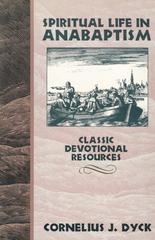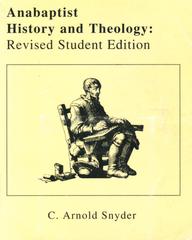Guide to the Anabaptist Martyrs of Europe: 1524-1614
2018, 63 pp
For more than 200 years, Martyrs’ Mirror (published in 1660) was the primary source for information about the
martyrs of the 16th-century Anabaptist movement. Since the late 19th century, however, researchers have spent
a lot of time digging through the archives of Europe and uncovering new information.
It should be stated that the author of Martyrs’ Mirror, Tieleman Jansz van Braght, did not set out to write
objective history. He was writing for the edification and inspiration of his fellow Dutch Mennonites. Martyrs’
Mirror, therefore, is “two parts sermon and only one part history,” as David Weaver-Zercher put it in his recent
book Martyrs Mirror: A Social History. Van Braght had an agenda. His goal was to
highlight the lives of those he considered ideal martyrs. As a result, Martyrs’ Mirror does not contain records
of the revolutionary Anabaptists, nor does it include even those who recanted during torture or trial.
Thanks to the work of modern researchers, many errors contained in Martyrs’ Mirror (mostly incorrect dates)
have been discovered and reported in various places, including the old Mennonite Encyclopedia. The
Mennonite Encyclopedia has been out of print for years, but all the articles are available on the internet as the
Global Anabaptist Mennonite Encyclopedia Online (GAMEO). The information contained
in this Guide comes primarily from GAMEO, and secondarily from Martyrs’ Mirror itself.
The Marginal Mennonite Society wants to remember the Anabaptist martyrs not to glorify or idealize them but to understand their place in history. We agree with van Braght that the revolutionaries are not to be admired. But we include them in this guide because the Anabaptist movement cannot be fully understood without acknowledging their role. We do take issue with van Braght’s rejection of the Anabaptists who recanted. When reading van Braght’s sometimes overblown rhetoric, it seems that the martyrs he held in highest regard were those who sought after martyrdom. In our view, it’s one thing to die for your religious convictions if you have to do so. That’s admirable. But it’s another thing to believe that martyrdom is what God wants, that martyrdom glorifies or pleases God. As modern persons, we decline to endorse or support anyone who pursues martyrdom or who thinks a martyr’s death is evidence of a superior piety. In fact, Marginal Mennonites most identify with the Anabaptists who chose to recant (or who took advantage of opportunities to escape imprisonment) so that they might return to their homes and families and extend their days on earth.
The listings in the Guide are organized geographically, by country and city, and then chronologically within each city. This guide would be an excellent resource for anyone visiting Anabaptist history sites in Europe. If you’re reading this document on your phone or laptop, please note that the underscored items are clickable links that will take you to articles on the GAMEO website.
The author thanks Sam Steiner of Kitchener, Ontario, for his help in navigating the material and the sources found in the GAMEO articles.
The Marginal Mennonite Society wants to remember the Anabaptist martyrs not to glorify or idealize them but to understand their place in history. We agree with van Braght that the revolutionaries are not to be admired. But we include them in this guide because the Anabaptist movement cannot be fully understood without acknowledging their role. We do take issue with van Braght’s rejection of the Anabaptists who recanted. When reading van Braght’s sometimes overblown rhetoric, it seems that the martyrs he held in highest regard were those who sought after martyrdom. In our view, it’s one thing to die for your religious convictions if you have to do so. That’s admirable. But it’s another thing to believe that martyrdom is what God wants, that martyrdom glorifies or pleases God. As modern persons, we decline to endorse or support anyone who pursues martyrdom or who thinks a martyr’s death is evidence of a superior piety. In fact, Marginal Mennonites most identify with the Anabaptists who chose to recant (or who took advantage of opportunities to escape imprisonment) so that they might return to their homes and families and extend their days on earth.
The listings in the Guide are organized geographically, by country and city, and then chronologically within each city. This guide would be an excellent resource for anyone visiting Anabaptist history sites in Europe. If you’re reading this document on your phone or laptop, please note that the underscored items are clickable links that will take you to articles on the GAMEO website.
The author thanks Sam Steiner of Kitchener, Ontario, for his help in navigating the material and the sources found in the GAMEO articles.
| Type | |
| Genre | History, Introductory Reference |
| Expression | General Writing/Recording |
| Topic | Anabaptism, Martyrdom |
| Audience | Adults |
| Language | English |
| Publisher | Marginal Mennonite Society |

Please provide your contact information. We will check this item's availability and get back to you soon with the price and expected time of delivery.






















